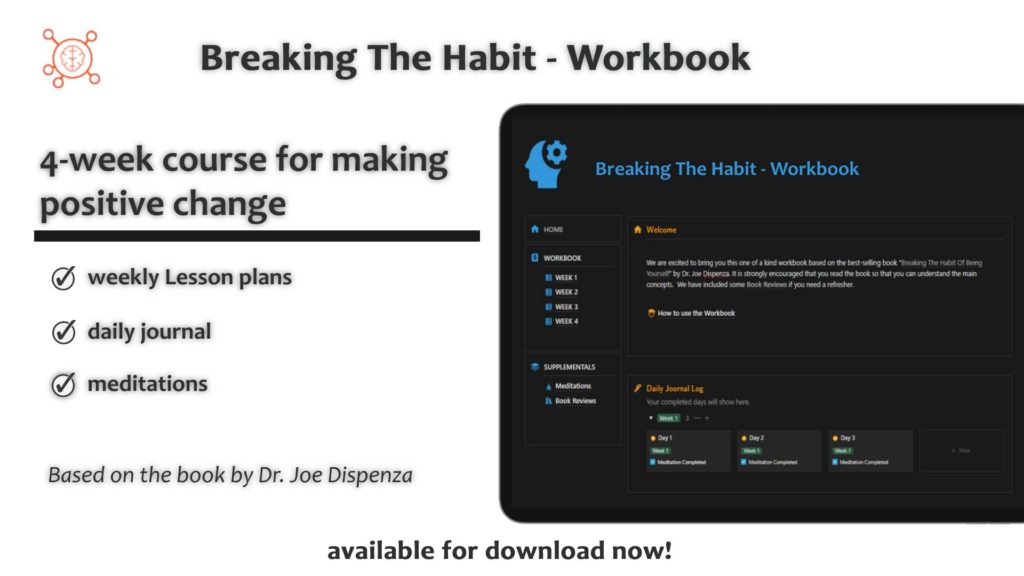The Habit of Being Yourself
Breaking the habit of being yourself is a transformative process that involves rewiring the neural pathways in the brain. This process can be supported by various techniques such as meditation, visualization, and cultivating positive emotions. In this article, we will delve deeper into the science behind breaking the habit of being yourself and explore the different techniques that can be used to support this process.
The Brain and Neuroplasticity
The human brain is a complex organ that is capable of change and adaptation. This ability is known as neuroplasticity. Neuroplasticity refers to the brain’s ability to change and adapt in response to new experiences, learning, and environmental factors. The concept of neuroplasticity is crucial in understanding how habits are formed and how they can be broken.
When we repeatedly engage in a particular behavior, the neural pathways associated with that behavior become stronger and more efficient. Over time, this can make the behavior feel automatic and effortless. It becomes a habit. However, the brain is not fixed or predetermined. Through conscious effort and practice, we can create new neural pathways that support different behaviors and thought patterns. This is the basis of Joe Dispenza’s teachings on breaking the habit of being yourself.
Meditation and Neuroplasticity
Meditation is a powerful tool that can promote neuroplasticity and support the creation of new neural pathways in the brain. Research has shown that regular meditation practice can have a range of benefits for brain function, including changes in brain waves, improved cognitive function, and stress reduction.
During meditation, the brain shifts from its normal waking state to a more relaxed and focused state. This shift is reflected in changes in brain waves, with slower and more synchronized activity in the prefrontal cortex and other regions of the brain.
These changes in brain waves have been associated with improved attention, cognitive function, emotional regulation, and stress reduction. By practicing meditation regularly, we can learn to shift our brain activity in a way that supports the creation of new neural pathways and the breaking of old habits.
Visualization and Positive Emotions
Visualization is another technique that can be used to create new neural pathways in the brain. By visualizing positive outcomes and experiences, we can activate the same neural pathways that would be activated if we were actually experiencing those outcomes and experiences. This can help to create new neural pathways that support positive change and personal growth.
Similarly, cultivating positive emotions such as love, gratitude, and joy can also support the creation of new neural pathways. When we repeatedly experience positive emotions, we create neural pathways that become associated with those emotions. By consciously choosing to focus on positive emotions and cultivating a more positive emotional state, we can create new neural pathways that support the breaking of old habits and the creation of new ones.
The Role of Repetition and Persistence
Breaking the habit of being yourself requires conscious effort and persistence. Creating new neural pathways takes time and repetition. It may be helpful to set specific goals and create a plan for achieving those goals, as well as seeking support from others who are also committed to personal growth.
It’s also important to be patient and kind to ourselves. Breaking old habits can be challenging, and setbacks are to be expected. But with persistence and commitment, it is possible to create positive change and live a more fulfilling life.
The Role of Mindfulness
Mindfulness is a state of awareness that involves being present in the moment and non-judgmentally observing thoughts, feelings, and sensations. Mindfulness can be practiced through meditation, but it can also be applied to everyday activities such as eating, walking, or washing dishes.
Research has shown that mindfulness can promote neuroplasticity and support the creation of new neural pathways in the brain. One study found that mindfulness meditation can increase the thickness of the prefrontal cortex, which is involved in attention, decision-making, and emotion regulation.
Another study found that mindfulness can reduce activity in the amygdala, which is responsible for processing emotions such as fear and anxiety. By reducing activity in the amygdala, mindfulness can help to reduce the influence of negative emotions on behavior and support the creation of new neural pathways that are associated with positive emotions and behaviors.
Mindfulness can also be used to increase self-awareness and identify the triggers and patterns associated with old habits. By becoming more aware of our thoughts and behaviors, we can begin to make conscious choices that support the creation of new habits and behaviors.
The Power of Affirmations
Affirmations are positive statements that are repeated frequently to support the creation of new neural pathways in the brain. Affirmations can be used to challenge negative self-talk and support the development of a more positive self-image.
Research has shown that affirmations can be an effective tool for promoting positive change and personal growth. One study found that affirmations can increase activity in the reward center of the brain, which is associated with positive emotions and motivation.
Affirmations can also be used to support the development of new habits and behaviors. By repeating affirmations that support the desired behavior or habit, we can create new neural pathways that support that behavior.
The Importance of Sleep
Sleep plays a crucial role in the brain’s ability to create and strengthen new neural pathways. During sleep, the brain consolidates memories and processes information from the day. This process is essential for the creation of new neural pathways and the breaking of old habits.
Research has shown that lack of sleep can interfere with neuroplasticity and make it more difficult to create new habits and behaviors. One study found that sleep deprivation can reduce activity in the prefrontal cortex, which is involved in decision-making and self-control.
To support the creation of new habits and behaviors, it’s important to prioritize getting enough sleep each night. This can involve creating a consistent sleep routine, avoiding screens before bed, and creating a comfortable sleep environment.
Incorporating Movement and Exercise
Physical movement and exercise can also support the creation of new neural pathways in the brain. Exercise has been shown to increase the production of brain-derived neurotrophic factor (BDNF), which is a protein that supports the growth and survival of neurons.
By incorporating movement and exercise into our daily routine, we can support the brain’s ability to create new neural pathways and support the breaking of old habits. This can involve engaging in activities such as yoga, dancing, or hiking, as well as incorporating regular exercise into our routine.
Conclusion
Breaking the habit of being yourself is a transformative process that involves the brain’s ability to change and adapt through neuroplasticity. Techniques such as mindfulness, affirmations, sleep, and movement can support the creation of new neural pathways that support positive change and personal growth.
By incorporating these techniques into our daily routine and committing to personal growth, it is possible to break old habits and create a more fulfilling life. Remember, this process takes time and persistence, but with patience and commitment, it is possible to create positive change and live a more fulfilling life.

